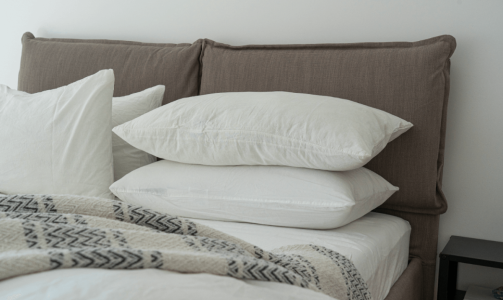Here’s why you should wash your pillows every month
- Replies 5
In the pursuit of a rejuvenating night's sleep, we generally focus on the comfort of our mattresses and the softness of our sheets. But most of us overlook one vital element: our faithful companions that cradle our weary heads night after night—our pillows.
Yes, those seemingly innocuous bundles of softness are more than just a resting place for our dreams; they hold the key to unlocking a truly blissful slumber.
Yet, despite their unwavering loyalty, our pillows can become unwitting hosts to many unwelcome guests: sweat, dust mites, dead skin cells, and even the occasional spill.
It's no secret that many of us tend to neglect the important task of cleaning and maintaining our pillows. However, Carolina McCauley, a laundry expert and devoted mother from Perth, wants to change that.
She suggested that we should wash our pillows every month. By doing so, we can significantly decrease our exposure to dust and dust mites, which have the potential to trigger allergies and other health problems.

Now, before you start worrying about the extra chore we've just added to your monthly to-do list, let us explain the simple process recommended by Carolina.
All you need are five common household ingredients: bicarb soda, gentle detergent mixed with hydrogen peroxide, white vinegar, eucalyptus oil, and three dryer balls to maintain the shape of your pillows. With these items in hand, you'll be on your way to fresher, cleaner pillows in no time.
But before we dive into the details, it's essential to read the label on your pillows. Different types of pillows require different cleaning methods.
According to Australian consumer company CHOICE, memory foam pillows should be spot cleaned, while latex pillows should be hand washed. Polyester, cotton, and microfibre pillows can be machine washed on a gentle cycle, and pillows made with goose down or goose feathers should be dry cleaned.
Assuming you have pillows that can be machine washed, start by placing two pillows in the washing machine, ensuring there's enough space to prevent overcrowding. Then, add half a cup of bicarb soda directly into the barrel and pour one lid full of gentle detergent into the detergent drawer along with a quarter cup of hydrogen peroxide to eliminate bacteria.
For the next step, pour half a cup of white vinegar into the fabric softener drawer and add a few drops of eucalyptus oil to effectively kill dust mites. Put three dryer balls into the machine along with your pillows, then select a gentle wash cycle.
To ensure proper cleaning of any pillow type, it is crucial to allow it to dry thoroughly on the inside, preventing the growth of mould and mildew. The ideal approach is to lay the pillow flat to dry under direct sunlight, which also acts as an additional antibacterial agent, keeping your pillows fresh.
Prior to placing it back on the bed, make sure to check for any residual moisture.
While certain pillows can be dried in a clothes dryer, it is advisable to consult the manufacturer's instructions before attempting this method. It is important to note that memory foam pillows should never be placed in the dryer, as this can cause damage to the material.
If the instructions for your specific pillow type indicate that it can be dried in a dryer, it is recommended to use a low-heat setting. Additionally, consider drying only a couple of pillows at a time to prevent them from clumping together.
Aside from keeping allergies at bay and maintaining a healthy environment, regular pillow washing can also help prevent unsightly yellow stains or discolouration.
As CHOICE experts explained, 'It's not pleasant to think about, but when you sleep on a pillow, the oils from your skin and hair combine with sweat and drool into one icky mess that's absorbed into the material of your pillow.'
They added, 'Even if it's covered up by a lovely floral pillowcase, it's still there and could be breeding bacteria and mould or housing allergens.'

So, our dear members, now that you know the reason behind washing pillows every month, it's time to give those pillows some much-needed tender loving care. Your skin, allergies and overall health will thank you for it!
Do you have other pillow-washing tips to share? Let us know in the comments below!
Yes, those seemingly innocuous bundles of softness are more than just a resting place for our dreams; they hold the key to unlocking a truly blissful slumber.
Yet, despite their unwavering loyalty, our pillows can become unwitting hosts to many unwelcome guests: sweat, dust mites, dead skin cells, and even the occasional spill.
It's no secret that many of us tend to neglect the important task of cleaning and maintaining our pillows. However, Carolina McCauley, a laundry expert and devoted mother from Perth, wants to change that.
She suggested that we should wash our pillows every month. By doing so, we can significantly decrease our exposure to dust and dust mites, which have the potential to trigger allergies and other health problems.

Cleaning pillows at least once every month can prevent dust and dust mites. Credit: Pexels/Castorly Stock.
Now, before you start worrying about the extra chore we've just added to your monthly to-do list, let us explain the simple process recommended by Carolina.
All you need are five common household ingredients: bicarb soda, gentle detergent mixed with hydrogen peroxide, white vinegar, eucalyptus oil, and three dryer balls to maintain the shape of your pillows. With these items in hand, you'll be on your way to fresher, cleaner pillows in no time.
But before we dive into the details, it's essential to read the label on your pillows. Different types of pillows require different cleaning methods.
According to Australian consumer company CHOICE, memory foam pillows should be spot cleaned, while latex pillows should be hand washed. Polyester, cotton, and microfibre pillows can be machine washed on a gentle cycle, and pillows made with goose down or goose feathers should be dry cleaned.
Assuming you have pillows that can be machine washed, start by placing two pillows in the washing machine, ensuring there's enough space to prevent overcrowding. Then, add half a cup of bicarb soda directly into the barrel and pour one lid full of gentle detergent into the detergent drawer along with a quarter cup of hydrogen peroxide to eliminate bacteria.
For the next step, pour half a cup of white vinegar into the fabric softener drawer and add a few drops of eucalyptus oil to effectively kill dust mites. Put three dryer balls into the machine along with your pillows, then select a gentle wash cycle.
To ensure proper cleaning of any pillow type, it is crucial to allow it to dry thoroughly on the inside, preventing the growth of mould and mildew. The ideal approach is to lay the pillow flat to dry under direct sunlight, which also acts as an additional antibacterial agent, keeping your pillows fresh.
Prior to placing it back on the bed, make sure to check for any residual moisture.
While certain pillows can be dried in a clothes dryer, it is advisable to consult the manufacturer's instructions before attempting this method. It is important to note that memory foam pillows should never be placed in the dryer, as this can cause damage to the material.
If the instructions for your specific pillow type indicate that it can be dried in a dryer, it is recommended to use a low-heat setting. Additionally, consider drying only a couple of pillows at a time to prevent them from clumping together.
Aside from keeping allergies at bay and maintaining a healthy environment, regular pillow washing can also help prevent unsightly yellow stains or discolouration.
As CHOICE experts explained, 'It's not pleasant to think about, but when you sleep on a pillow, the oils from your skin and hair combine with sweat and drool into one icky mess that's absorbed into the material of your pillow.'
They added, 'Even if it's covered up by a lovely floral pillowcase, it's still there and could be breeding bacteria and mould or housing allergens.'
Key Takeaways
- Carolina McCauley shared a laundry tip for washing bedroom pillows using five household ingredients.
- According to Asthma Australia, washing pillows monthly can reduce the risk of exposure to dust and dust mites.
- The method shared by Carolina includes bicarb soda, gentle detergent mixed with hydrogen peroxide, white vinegar, and eucalyptus oil, along with three dryer balls to maintain the shape of the pillows.
- The cleanliness of your pillow can help ease allergies and keep your skin free from blemishes.
So, our dear members, now that you know the reason behind washing pillows every month, it's time to give those pillows some much-needed tender loving care. Your skin, allergies and overall health will thank you for it!
Do you have other pillow-washing tips to share? Let us know in the comments below!







